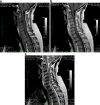Treatment of spondylodiscitis
- PMID: 22143315
- PMCID: PMC3282845
- DOI: 10.1007/s00264-011-1425-1
Treatment of spondylodiscitis
Abstract
Purpose: Pyogenic infections of the spine are relatively rare with an incidence between 1:100,000 and 1:250,000 per year, but the incidence is increasing due to increases in average life-expectancy, risk factors, and medical comorbidities. The mean time in hospital varies from 30 to 57 days and the hospital mortality is reported to be 2-17%. This article presents the relevant literature and our experience of conservative and surgical treatment of pyogenic spondylodiscitis.
Method: We have performed a review of the relevant literature and report the results of our own research in the diagnosis and treatment of pyogenic spondylodiscitis. We present a sequential algorithm for identification of the pathogen with blood cultures, CT-guided biopsies and intraoperative tissue samples. Basic treatment principles and indications for surgery and our surgical strategies are discussed.
Results: Recent efforts have been directed toward early mobilisation of patients using primary stable surgical techniques that lead to a further reduction of the mortality. Currently our hospital mortality in patients with spondylodiscitis is around 2%. With modern surgical and antibiotic treatment, a relapse of spondylodiscitis is unlikely to occur. In literature the relapse rate of 0-7% has been recorded. Overall the quality of life seems to be more favourable in patients following surgical treatment of spondylodiscitis.
Conclusion: With close clinical and radiological monitoring of patients with spondylodiscitis, conservative and surgical therapies have become more successful. When indicated, surgical stabilisation of the infected segments is mandatory for control of the disease and immediate mobilisation of the patients.
Figures



References
Publication types
MeSH terms
Substances
LinkOut - more resources
Full Text Sources

